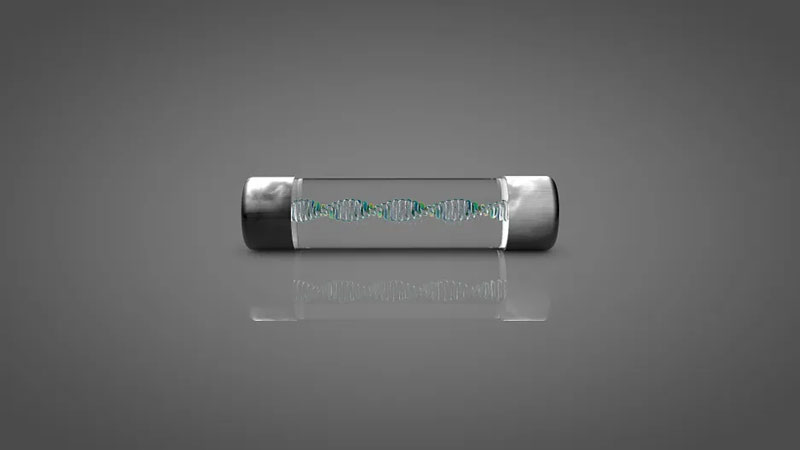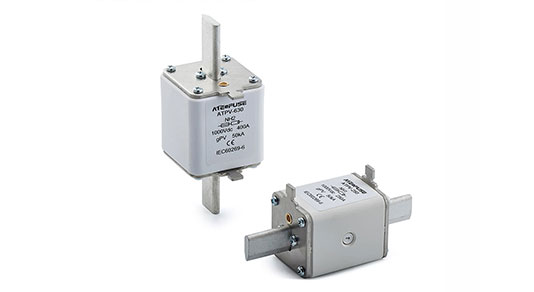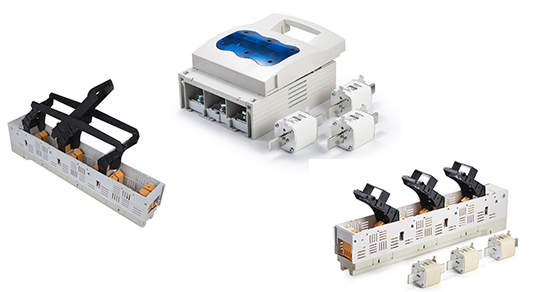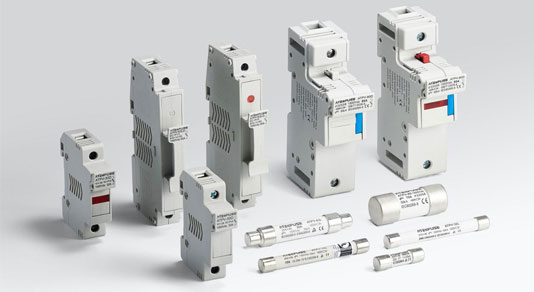Fuses (For Beginners), AC Fuse In DC Circuits
DC Fuses are used for Direct Current applications. They are used to separate the load from the source in an abnormal case. They are not usable once they perform their task, but also, they are cheaper than the Circuit Breaker.
Can fuses with an AC voltage rating be used in a DC applications?
Fuses must be rated for the voltage AC or DC in which they will be used. Generally, fuses have a DC voltage rating that is half of the maximum AC voltage rating. (Example: LLSRK_ID - 600 VAC, 300VDC) Consult the factory for specific DC voltage ratings.
Fuses (For Beginners), AC Fuse In DC Circuits

Nevr use AC fuse in DC circuits
In practical life as electrical engineers and electricians we some times inspect control circuits and distribution panels, and realize that AC fuses are used in DC circuits!
What Is A Fuse?
We can define a fuse as an electrical safety equipment that protects electrical circuits from over current or during short circuits. Fuse is a simple but important protection component. No device is operational without a fuse.
AC Current Vs DC Current
Before diving into the reason of why you should never use AC fuse in DC circuits! lets discuss a little about the main difference between AC and DC current.
AC or alternating current, is that type of current which changes its direction and magnitude 50 or 60 times per second, this is why its called alternating, AC current crosses the zero value 50/60 times per second.
On the other hand DC current is a constant in both direction an magnitude, and doesn't go zero until the source of power is lost.
Crossing To Zero Helps Well
As mentioned above, AC current crosses zero potential 50/60 times per second and hence this zero value helps well in AC fuse designing, How is that? To better understand this we will take it from the fuse principle of protecting electrical circuits.
Fuse Principle Of Protection
A fuse consists of a metal filament. In normal conditions, a small or limited amount of current passes through the filament.
• When an overload or short circuit occurs, A large amount of current flows through the filament.
• Due to a large amount of flow of current filament heats up and melts.
• Due to melting of filament gape creates among the fuse elements and the flow of current stop.
The filament thickness & length determine the rated current of the fuse. Once the flow of current is stopped, the protected device stops operation. And protection occurred against over current.
While talking about the material used in the filament. Normally it is made of copper, Zinc, Silver, aluminum, or any other alloy having a predictable trip current.
In other words, fuses are a simple circuit breaker device with one time use, it is used to protect AC and DC circuits against overcurrent and short circuit conditions.
When DC or AC current passes through an electrical conductor of any size it produces temperature rise depending on conductor size and current value.
In case of the current passing through the AC fuse or DC fuse exceed the rating value of the fuse, the temperature rises more and more, and the fuse element will no longer be able to withstand and then blows.
At the moment of fuse blowing the current keeps passing through air between the fuse element blown parts producing an arc.
What Will Cause The Arc To Extinguish?
In AC fuse case
As AC current goes zero several times each second this zero value helps the arc to be extinguished.
In DC fuse case
The current never goes zero, so it is more difficult to extinguish DC arc than AC one, For that reason DC fuses are designed to be longer than AC ones, this extra length helps in DC arc extinguishing.
The main question is, Could AC fuses be used in DC circuits? The answer is clearly, Never do that. AC fuse in DC circuits is dangerous! Using AC fuse in DC circuits will cause the arc not to be extinguished safely and may cause fire situation.
Different Types Of Fuses
As discussed above, fuse is an important protective device. Two main types of systems are in use nowadays. i.e. AC and DC. Therefore, types of fuses are also of two types. i.e. AC Fuse and DC Fuses.
AC Fuses
Ac fuses consist of Low and High voltage fuses. These are further divided in such a manner.
Low Voltage fuses
This type of fuses is used in low voltage distribution networks. The different types of low voltage fuses are.
• Switch Fuse
• Cartridge fuse
• Rewirable fuse
• Drop out fuse.
• Sticker fuse.
High voltage fuses
This type of fuses is used in high voltage AC transmission lines. It consists of:
• Expulsion fuse.
• High Rapture current (HRC)FUSE.
DC Fuses
Dc fuses are manufactured for Direct current equipment. Different types of DC fuses are:
• Cartridge fuse.
• Automotive fuse.
• Resettable fuse.
• Semiconductor, and over-voltage suppression fuses.
Do Fuse Have A Positive And A Negative End?
Fuses have no polarity and no positive or negative sides; they can be placed in any polarity fuse holder. In a typical circuit, a fuse is a conductor. As a result, it lacks any sense of direction, polarity, or orientation. Due to the high melting point of the Fuse, regardless of the current direction, the Fuse will shut off the current route.
A semiconductor Fuse differs from a time-delay Fuse in that it is made of pure silver and, in the case of the short circuit, has quick melting properties, which is why it is also known as a fast-acting Fuse.
Do All Fuses Do The Same Things?
Although not all fuses operate the same way, they are all affected by overload current and the length of time they have been in operation. A fuse that is indestructible does not exist. Even the most perfect electrical system, which never overloads, will blow a fuse at some point.
A fuse serves as a sacrificial device, according to Little fuse's "Fuseology." A conductive strip of material within a fuse, commonly known as its "breaking capability" melts if the Fuse is overloaded. When a system overloads or shorts, the Fuse protects the more extensive system by breaking the circuit or "opening."
The great majority of fuses used in automobile electrical applications are "blade" fuses, which have two prongs that fit into a tiny socket. However, as more cars are outfitted with extras that require higher current carrying capacities, the usage of bolt-down fuses has expanded, and cartridge fuses have become popular in instances for optimal space use, smaller footprints are required.
Can Fuse Protect Against Hight Voltage?
Yes, Fuse can protect against High Voltage, but for this purpose, you’ll need a suitably rated fuse to safeguard a circuit from high voltage. When a high voltage travels through a thin metal wire, the metal warms up and melts, causing the circuit to break.
A fuse is temperature-dependent due to the demand for melting metal. A fuse in an oven or furnace will blow with less current, but a fuse in a frigid environment may require many times, if not decades, more current to blow than a fuse at an average temperature.
Another scenario is the manner in which the Fuse blows. If there is a minor overcurrent, the Fuse may take several minutes to melt and open-circuit. If the Fuse is blown by a 1,000-A short-circuit, the metal will melt, effectively exploding inside the insulating shell.
A high-voltage fuse must have creepage and clearance distances between its terminals that exceed safety requirements, in addition to assuring that the Fuse will break a high-voltage circuit regardless of how quickly or slow it explodes.
Does Voltage Affect A Fuse?
Yes, of course, voltage affects a fuse, and the specified Fuse's voltage rating must be more than or equal to the circuit voltage. Due to the low resistance of fuses, the voltage rating is only relevant while the Fuse is attempting to open.
Fuse elements must have the ability to open fast and extinguish the arc once melted, as well as prevent the open-circuit voltage in the system from striking across the open fuse element.
Fuse links are voltage-sensitive devices, and it's crucial to remember that a fuse link’s ability to function appropriately during fault situations is determined by the system voltage.
As a result, they must not be used in circuits with voltages higher than their rated voltage. They can, however, be successfully employed in circuits with lower voltage levels.
Why Do Fuses Have Voltage Ratings?
Fuses have a voltage rating because the rating is set by its capacity to open a circuit in the event of an overcurrent scenario. The voltage rating, in particular, impacts the Fuse’s capacity to inhibit internal arcing that happens when a fuse link melts, and an arc is formed.
Arc suppression will be compromised if a fuse with a voltage rating lower than the circuit voltage is employed. The Fuse may not clear the overcurrent safely under some overcurrent situations.
When supplied from three-phase, securely grounded, 480/277V circuits with a single-phase line-to-neutral voltage of 277V, 300V rated fuses can be used to safeguard single-phase line-to-neutral loads.
This is legal since a 300V fuse will not have to interrupt a voltage more extensive than its 300V rating in this application. Special care is required when a semiconductor fuse is used on a circuit with a lower voltage Rating.
Read also my article, How temperature rise affect electrical equipment.
Is It Normal For A Car Fuse To Get Hot?
No, it’s not normal for any fuse to get hot. You don't ignore this if your car fuses getting hot. Current passing via a resistance causes fuse heating in a car's electrical circuit.
A current much below the fuse rating might create enough heat to melt an inline fuse holder if there is substantial resistance in the contact between the Fuse and the fuse holder.
It's worth noting that the heating of the car's electrical Fuse isn't always quick. While the initial resistance may be more minor, and the first heating may not be sufficient to reach the fuse melting point, the heat might produce oxidation of the metal connections, increasing contact resistance.
Causes A Fuse To Get Hot
• Too many aftermarket devices (cell phone charger, G.P.S. equipment, Stereo amplifier, etc.) connected to the circuit might create an excessive current flow that leads to the car fuse getting hot.
• The factory-installed gadget that is starting to malfunction because it is sucking too much current can be caused to fuse getting hot.
• Corroded connections, wiring, or a device that is beginning to malfunction and impeding normal current flow are all causes of high resistance that can cause heating car fuses.
You'll have to isolate the individual circuits, leaving the fuse panel alone, and test them for current flow/draw. You can come across anything like a heater blower motor that is taking twice as much current as it should.
To check for high resistance, I'd isolate each circuit once again and run a voltage drop test across each one, including the fuse panel's power line.
It's possible that corrosion has developed inside a connection that you can’t see. Voltage drop testing, on the other hand, should allow you to pinpoint exactly which part of the wire, device, or connection is faulty.
What Are The Standard Fuse Sizes?
Per 240.6 Fuse and fixed trip circuit breakers are available in the following sizes: 15, 20, 25, 30, 35, 40, 45, 50, 60, 70, 80, 90, 100, 110, 125, 150, 175, 200, 225, 250, 300, 350, 400, 450, 500, 600, 700, 800, 1000, 1200, 1600, 2000, 2500, 3000, 4000, 5000, and 6000 amps, instead of these Additional standard fuse sizes are 601 and 10, 6, 3, 1 amp.
Should Fuse Be On Positive Or Negative?
The requisite protection would be provided by a fuse alone on the positive terminal enough to protect your electrical circuit. A fuse should be placed as near to the source as practicable.
One reason is that fuse isolators are widely utilized in AC applications where both the Live and Neutral must be disconnected. Even so, a fuse on the live and a link on the neutral can be used.
What Causes A Fuse To Blow?
A short circuit should always trip a breaker or blow a fuse, and it may also create sparks, popping sounds, and potentially smoke. If you're wondering what went wrong and how a short circuit "blow a fuse," check out the list below.
The Wrong Type Of Fuse Was Installed
Fuses are available in a variety of forms, sizes, and combinations. Many appear identical yet have extremely diverse purposes if you or someone else inserted the incorrect rating fuse in a fuse holder, so it can be the cause of below the fuse when the device operates because the device has drawn a higher current than the rated Value of fuse.
Damaged Or Outdated Electrical Outlets
Any defective wiring or linked elements run the danger of causing a power failure (surge) that blows a fuse. So, once again, the issue is not that the fuse failed to function correctly but rather that there was malfunctioning equipment.
An Overloaded Circuit
You should be able to identify the perpetrator in this scenario by checking for an overloaded outlet or an individual appliance. Consider a power strip with a plug-in in every outlet, especially if the devices connected are high-energy users.
A Short Circuit
A sort of electrical defect is a short circuit. Faults arise when an electrical current deviates from its intended course (circuit) owing to a lack of resistance (e.g., from insulation or a circuit breaker).
As a result, the connection between the two conductors delivering electrical power to the circuit is compromised, and the impact of the "short" or "fault" excessive current flows into the power source. Wires that are overloaded will overflow and cause harm. A short circuit may potentially destroy the electrical item that caused it.
A Ground Fault
A ground fault is a form of short circuit in which the stray electrical current passes directly to the Earth (ground) or contacts a grounded element of the system.
When a person touches the weak path to the ground, the risk of shock rises. As a result, G.F.C.I. (ground fault circuit interrupter) outlets are commonly seen in kitchens and restrooms.
An Arc Fault
Arc faults are caused by wiring and terminal connection issues, such as a loose terminal screw. If your house contains arc fault circuit interrupters (AFCIs) and they are up to date, they will trip a circuit if a spark occurs along with defective wiring.





